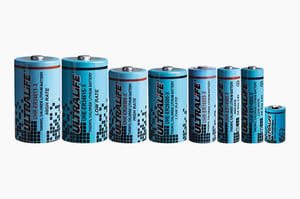To help design engineers quickly identify the ideal characteristics of ER cell batteries for their fixed or portable applications, Ultralife has created an infographic exploring the battery requirements of devices in six varied industrial markets.
One cell, many applications

It is this versatility that prompted Ultralife Corporation to refine its own ER cell offering, with the launch of the ER Generation X range. These batteries are available with either spiral or bobbin cell constructions in a range of footprints.
One size does not fit all
There is no universal solution as far as batteries are concerned, at least if they are expected to perform well in the application. Most design engineers will have certain performance features that they want from their application already in mind. Choosing the correct battery based on intended operating conditions is vital to ensure lasting, effective energy.
For example, the environmental conditions of a smart meter compared to an oil and gas instrumentation device are vastly different. In the former, batteries will operate at room temperature and rarely be exposed to shock, vibration or other rough conditions. Oil and gas devices are the opposite — they operate in harsh environments, with extreme high temperatures for certain downhole instrumentation. As such, the battery must be rugged and boast an extended temperature range.
However, there is one thing that all six of the specified applications have in common, which is the need to transmit data: whether it is asset tracking tags or sonobuoys transmitting geographical information, smart meters sending energy usage data to the billing company, oil and gas instrumentation reporting on the performance of the pipeline, or smart LED lighting switching on or off by voice or remote control.
A matter of time
Yet, the amount of time that data transmissions occur can vary depending on each individual device. When selecting a battery, OEMs and design engineers need to consider if the battery is going to be constantly active and sending consistent power to a device, or if it will lie dormant (as a back-up battery or for power-saving) for extended periods and then need a high burst of energy. This affects the type of battery properties needed, and whether the high-capacity bobbin construction is preferable to the higher power of a spiral construction.
Ultralife’s infographic suggests what the ideal properties for each application could be, such as lightweight, high power batteries for radio devices, and long-lasting batteries with low self-discharge for asset tracking. The graphic also provides an indication of the ideal cell constructions for these applications where possible.
Application areas can have common challenges and trends, but each individual device will still differ. The infographic may not give definitive answers to every question for all applications because they are often situation dependent. But it will help to guide design engineers into making better battery choices.

For specific project needs, the best option is always to consult directly with a battery specialist: